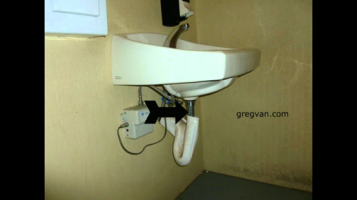-
Welcome to The Building Code Forum
Your premier resource for building code knowledge.
This forum remains free to the public thanks to the generous support of our Sawhorse Members and Corporate Sponsors. Their contributions help keep this community thriving and accessible.
Want enhanced access to expert discussions and exclusive features? Learn more about the benefits here.
Ready to upgrade? Log in and upgrade now.
You are using an out of date browser. It may not display this or other websites correctly.
You should upgrade or use an alternative browser.
You should upgrade or use an alternative browser.
Construction tolerance allowed on under Lav pipe wrap?
- Thread starter ADAguy
- Start date
mark handler
SAWHORSE
Yes the pipe wrap must completely cover exposed "P" drain pipe.
any portion can cause burns to legs of chair users and any abrasive areas can cause cuts or abrasions to legs.
any portion can cause burns to legs of chair users and any abrasive areas can cause cuts or abrasions to legs.
ADAguy
REGISTERED
Burns can only occur if contact is maintained for a period exceeding 3 minutes @ + 130 degrees. Cpc requires metered delivery for 25 seconds at no more than 120 degrees. If only 3/4" is exposed why is that not. OK? Also the connection to drain is clear of the minimum clearance reqd.
mark handler
SAWHORSE
Shall be covered.
steveray
SAWHORSE
606.6 Exposed Pipes and Surfaces. Water supply and
drainpipes under lavatories and sinks shall be insulated
or otherwise configured to protect against contact.
There shall be no sharp or abrasive surfaces under lavatories
and sinks.
I wouldn't be in too much of a hurry to accept it, but it could be acceptable....
drainpipes under lavatories and sinks shall be insulated
or otherwise configured to protect against contact.
There shall be no sharp or abrasive surfaces under lavatories
and sinks.
I wouldn't be in too much of a hurry to accept it, but it could be acceptable....
mtlogcabin
SAWHORSE
I never believed it was a burn issue to people as much as the sharp or abrasive surfaces. The elderly have thin skin
Fragile or thin skin that tears easily is a common problem in older adults. Aging, sun exposure and genetics all play a role in thinning skin. Certain medications, such as long–term use of oral or topical corticosteroids, also can weaken skin and the blood vessels in the skin.
http://www.mayoclinic.org/healthy-lifestyle/healthy-aging/expert-answers/thin-skin/faq-20057753
Fragile or thin skin that tears easily is a common problem in older adults. Aging, sun exposure and genetics all play a role in thinning skin. Certain medications, such as long–term use of oral or topical corticosteroids, also can weaken skin and the blood vessels in the skin.
http://www.mayoclinic.org/healthy-lifestyle/healthy-aging/expert-answers/thin-skin/faq-20057753
ADAguy
REGISTERED
Steve as I then see it, around vertices drain a as shown could not be assumed to have exposed edges and as much as 1-2" could be exposed .
Mr. Inspector
SAWHORSE
Old people need to wear pants.
steveray
SAWHORSE
It is a call for each individual inspector to make.....
mark handler
SAWHORSE
Could be a lawsuit., but it could be acceptable....
Old people need to wear pants.
Rick, How bout a kilt, will that work for you!
steveray
SAWHORSE
Could be a lawsuit.
Yes....Yes it could.
Yikes
SAWHORSE
Interesting that the code used to say "insulate hot and waste pipes", indicating it was a temperature issue.
Now, 606.5 says "water supply and drainpipes under lavatories and sinks shall be insulated...". It makes no distinction whether the water supply is hot or not. And it also mentions "no sharp or abrasive surfaces under lavatories or sinks".
And yet, there is no similar requirement (to insulate and avoid sharpness) for drinking fountains, which may also have exposed water supply and waste. A code oversight, perhaps?
Now, 606.5 says "water supply and drainpipes under lavatories and sinks shall be insulated...". It makes no distinction whether the water supply is hot or not. And it also mentions "no sharp or abrasive surfaces under lavatories or sinks".
And yet, there is no similar requirement (to insulate and avoid sharpness) for drinking fountains, which may also have exposed water supply and waste. A code oversight, perhaps?
ADAguy
REGISTERED
Thank you for pointing out that nuisance, is it the same for both cbsc n ada?
steveray
SAWHORSE
Interesting that the code used to say "insulate hot and waste pipes", indicating it was a temperature issue.
Now, 606.5 says "water supply and drainpipes under lavatories and sinks shall be insulated...". It makes no distinction whether the water supply is hot or not. And it also mentions "no sharp or abrasive surfaces under lavatories or sinks".
And yet, there is no similar requirement (to insulate and avoid sharpness) for drinking fountains, which may also have exposed water supply and waste. A code oversight, perhaps?
2021 ANSI will pick that up....
mark handler
SAWHORSE
That's because of sharp and abrasive valves/joints, not just hot water.Interesting that the code used to say "insulate hot and waste pipes", indicating it was a temperature issue.
Now, 606.5 says "water supply and drainpipes under lavatories and sinks shall be insulated...". It makes no distinction whether the water supply is hot or not. And it also mentions "no sharp or abrasive surfaces under lavatories or sinks".
And yet, there is no similar requirement (to insulate and avoid sharpness) for drinking fountains, which may also have exposed water supply and waste. A code oversight, perhaps?


